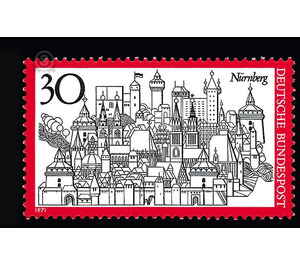tourism - Germany / Federal Republic of Germany 1971 - 30 Pfennig
Theme: Architecture
| Country | Germany / Federal Republic of Germany |
| Issue Date | 1971 |
| Face Value | 30.00 |
| Color | black grey orange |
| Perforation | K 14 |
| Printing Type | Intaglio and offset printing |
| Stamp Type | Postage stamp |
| Item Type | Stamp |
| Chronological Issue Number | 567 |
| Chronological Chapter | GER-BRD |
| SID | 692583 |
| In 54 Wishlists | |
The special stamp "Nuremberg" appears in the series dedicated to the tourist areas and places. It is a contribution to Dürerjahr. Nuremberg was one of the most important cities in Europe during the Middle Ages. The original cell of the city was the royal castle, which was first mentioned in documents in 1050. Its economic and cultural high point experienced the free imperial city in the Dürerzeit. In addition to Dürer, the sculptor Veit Stoß, the sculptor Adam Kraft, the ore-founder Peter Vischer and the poet Hans Sachs worked at that time. In 1806 Nuremberg lost its independence and fell to Bavaria. The economic boom in the 19th century, which made the city the economic center of northern Bavaria, is characterized by the construction of the first German railway from Nuremberg to Fürth (1835) and the emergence of large companies in the machine and electrical industry, whose products gained world renown. During the Second World War, the city center was almost completely destroyed in 1945. During the reconstruction, it was possible to combine the old and the new in a good relationship. The castle still dominates the cityscape. The almost completely preserved medieval wall ring encloses today the old town.


